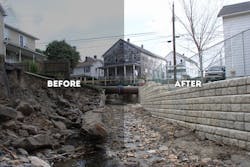After Massive Flood, Channel Protects Neighborhood
On July 3, 2011, a storm poured 5 to 6 in. of rain into Coal Creek in Plymouth, Pa., causing massive flooding that blocked bridges, destroyed streets, tore homes from their foundations and displaced hundreds of residents.
“The flooding at this site happened because two bridges upstream became blocked and the water overtopped the bridges,” said Joe Rutkoski, engineering technician with the U.S. Department of Agriculture’s (USDA) Natural Resources Conservation Service. “It was a freak local storm; it wasn’t even one of the major storms that hit the East Coast.”
The damage, which was estimated at around $5 million, fell well short of the threshold required to trigger federal aid. So federal, state and county officials worked together to obtain upwards of $1 million in public and private funds to restore the Coal Creek area. The Luzerne Conservation District and the USDA were particularly involved in the project.
Once funding was secure, officials were challenged to find a solution to reinforce the creek banks. The solution needed to stand up to flooding, have the ability to be built within a tight footprint and be aesthetically pleasing to fit into this residential setting.
“Everything needed to be close to vertical to keep the channel from taking up too much space in the residential yards,” said Rutkoski. “There really was no way to fit natural stone or riprap in the space available. We knew we needed some type of manufactured stone block.”
The solution
With those criteria in mind, officials turned to Redi-Rock products from local manufacturer Smith Wilbert Inc.
“Redi-Rock just made really good sense for this situation,” said Michael W. Derr, P.E., project engineer for Geo-Technology Associates Inc. “Two of the houses have driveways within 2 to 3 ft of the top of the wall, and other houses were within 20 to 25 ft of the wall. Obviously you can't have significant excavation back for geogrid. There were significant excavation limits.”
Each one-ton Redi-Rock block harnesses the power of gravity, making it possible to build tall gravity walls without reinforcement in many applications. This reduces the need for excavation and allows walls to be built in tight spaces. A gravity solution was key for this project because designers needed to minimize encroachment on homeowners’ properties. Redi-Rock blocks utilize a knob-and-groove technology, which means that the entire retaining wall structure is interlocked. Each block is manufactured using architectural-grade precast concrete, ensuring walls will stand up to the elements.
“I used the Redi-Rock design software because this is a gravity wall,” Derr said. “We did a lot of global stability analysis for rapid drawdown because this is an area that is pretty steeply sloped and it’s subject to rapid drawdown. Global stability was a major concern because of the proximity to the houses, the road and driveways.”
The design of this restoration project required a total of three walls equaling about 8,050 sq ft of retaining walls. At the tallest point, these walls stood 13.5 ft tall, including embedment. The design included Redi-Rock 60-in. base blocks to add stability to the bases of the walls. These 60-in. blocks each weigh 3,290 lb, as much as a Chevy Corvette. Some sections included up to six courses of 60-in. base blocks. Above these, Redi-Rock 41-in. blocks were installed.
The result
After construction was completed, the design team was happy with the outcome.
“It’s just a proven system,” said Rutkoski. “Everything came out exactly as advertised, and we’d be happy to use the product again.”
The walls were put to the test during a large storm event in the summer of 2013. Plymouth Borough Mayor Dorothy Petrosky praised the walls' successful defense against "mother nature's fury.”
“The results are amazing," Petrosky said.
“I don’t have a doubt in my mind that without this, the Coal Creek area would have had very serious problems today,” said Plymouth Township Supervisor Gail Conrad.


